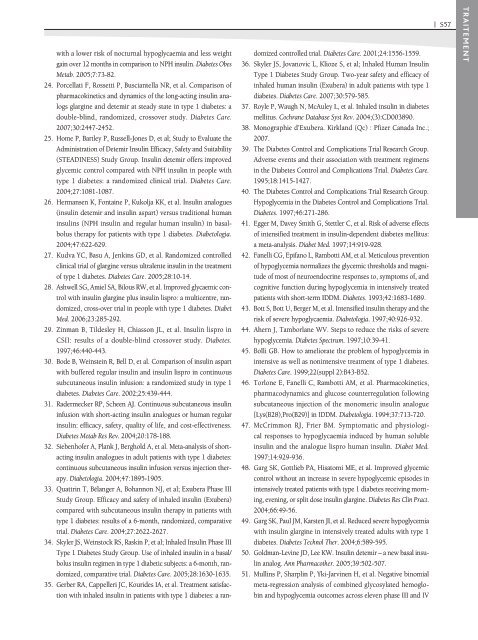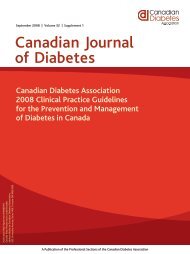Lignes directrices de pratique clinique 2008 de l - Canadian ...
Lignes directrices de pratique clinique 2008 de l - Canadian ...
Lignes directrices de pratique clinique 2008 de l - Canadian ...
You also want an ePaper? Increase the reach of your titles
YUMPU automatically turns print PDFs into web optimized ePapers that Google loves.
with a lower risk of nocturnal hypoglycaemia and less weight<br />
gain over 12 months in comparison to NPH insulin. Diabetes Obes<br />
Metab. 2005;7:73-82.<br />
24. Porcellati F, Rossetti P, Busciantella NR, et al. Comparison of<br />
pharmacokinetics and dynamics of the long-acting insulin analogs<br />
glargine and <strong>de</strong>temir at steady state in type 1 diabetes: a<br />
double-blind, randomized, crossover study. Diabetes Care.<br />
2007;30:2447-2452.<br />
25. Home P, Bartley P, Russell-Jones D, et al; Study to Evaluate the<br />
Administration of Detemir Insulin Efficacy, Safety and Suitability<br />
(STEADINESS) Study Group. Insulin <strong>de</strong>temir offers improved<br />
glycemic control compared with NPH insulin in people with<br />
type 1 diabetes: a randomized clinical trial. Diabetes Care.<br />
2004;27:1081-1087.<br />
26. Hermansen K, Fontaine P, Kukolja KK, et al. Insulin analogues<br />
(insulin <strong>de</strong>temir and insulin aspart) versus traditional human<br />
insulins (NPH insulin and regular human insulin) in basalbolus<br />
therapy for patients with type 1 diabetes. Diabetologia.<br />
2004;47:622-629.<br />
27. Kudva YC, Basu A, Jenkins GD, et al. Randomized controlled<br />
clinical trial of glargine versus ultralente insulin in the treatment<br />
of type 1 diabetes. Diabetes Care. 2005;28:10-14.<br />
28. Ashwell SG, Amiel SA, Bilous RW, et al. Improved glycaemic control<br />
with insulin glargine plus insulin lispro: a multicentre, randomized,<br />
cross-over trial in people with type 1 diabetes. Diabet<br />
Med. 2006;23:285-292.<br />
29. Zinman B, Til<strong>de</strong>sley H, Chiasson JL, et al. Insulin lispro in<br />
CSII: results of a double-blind crossover study. Diabetes.<br />
1997;46:440-443.<br />
30. Bo<strong>de</strong> B, Weinstein R, Bell D, et al. Comparison of insulin aspart<br />
with buffered regular insulin and insulin lispro in continuous<br />
subcutaneous insulin infusion: a randomized study in type 1<br />
diabetes. Diabetes Care. 2002;25:439-444.<br />
31. Ra<strong>de</strong>rmecker RP, Scheen AJ. Continuous subcutaneous insulin<br />
infusion with short-acting insulin analogues or human regular<br />
insulin: efficacy, safety, quality of life, and cost-effectiveness.<br />
Diabetes Metab Res Rev. 2004;20:178-188.<br />
32. Siebenhofer A, Plank J, Berghold A, et al. Meta-analysis of shortacting<br />
insulin analogues in adult patients with type 1 diabetes:<br />
continuous subcutaneous insulin infusion versus injection therapy.<br />
Diabetologia. 2004;47:1895-1905.<br />
33. Quattrin T, Bélanger A, Bohannon NJ, et al; Exubera Phase III<br />
Study Group. Efficacy and safety of inhaled insulin (Exubera)<br />
compared with subcutaneous insulin therapy in patients with<br />
type 1 diabetes: results of a 6-month, randomized, comparative<br />
trial. Diabetes Care. 2004;27:2622-2627.<br />
34. Skyler JS, Weinstock RS, Raskin P, et al; Inhaled Insulin Phase III<br />
Type 1 Diabetes Study Group. Use of inhaled insulin in a basal/<br />
bolus insulin regimen in type 1 diabetic subjects: a 6-month, randomized,<br />
comparative trial. Diabetes Care. 2005;28:1630-1635.<br />
35. Gerber RA, Cappelleri JC, Kouri<strong>de</strong>s IA, et al. Treatment satisfaction<br />
with inhaled insulin in patients with type 1 diabetes: a ran-<br />
domized controlled trial. Diabetes Care. 2001;24:1556-1559.<br />
36. Skyler JS, Jovanovic L, Klioze S, et al; Inhaled Human Insulin<br />
Type 1 Diabetes Study Group. Two-year safety and efficacy of<br />
inhaled human insulin (Exubera) in adult patients with type 1<br />
diabetes. Diabetes Care. 2007;30:579-585.<br />
37. Royle P, Waugh N, McAuley L, et al. Inhaled insulin in diabetes<br />
mellitus. Cochrane Database Syst Rev. 2004;(3):CD003890.<br />
38. Monographie d’Exubera. Kirkland (Qc) : Pfizer Canada Inc.;<br />
2007.<br />
39. The Diabetes Control and Complications Trial Research Group.<br />
Adverse events and their association with treatment regimens<br />
in the Diabetes Control and Complications Trial. Diabetes Care.<br />
1995;18:1415-1427.<br />
40. The Diabetes Control and Complications Trial Research Group.<br />
Hypoglycemia in the Diabetes Control and Complications Trial.<br />
Diabetes. 1997;46:271-286.<br />
41. Egger M, Davey Smith G, Stettler C, et al. Risk of adverse effects<br />
of intensified treatment in insulin-<strong>de</strong>pen<strong>de</strong>nt diabetes mellitus:<br />
a meta-analysis. Diabet Med. 1997;14:919-928.<br />
42. Fanelli CG, Epifano L, Rambotti AM, et al. Meticulous prevention<br />
of hypoglycemia normalizes the glycemic thresholds and magnitu<strong>de</strong><br />
of most of neuroendocrine responses to, symptoms of, and<br />
cognitive function during hypoglycemia in intensively treated<br />
patients with short-term IDDM. Diabetes. 1993;42:1683-1689.<br />
43. Bott S, Bott U, Berger M, et al. Intensified insulin therapy and the<br />
risk of severe hypoglycaemia. Diabetologia. 1997;40:926-932.<br />
44. Ahern J, Tamborlane WV. Steps to reduce the risks of severe<br />
hypoglycemia. Diabetes Spectrum. 1997;10:39-41.<br />
45. Bolli GB. How to ameliorate the problem of hypoglycemia in<br />
intensive as well as nonintensive treatment of type 1 diabetes.<br />
Diabetes Care. 1999;22(suppl 2):B43-B52.<br />
46. Torlone E, Fanelli C, Rambotti AM, et al. Pharmacokinetics,<br />
pharmacodynamics and glucose counterregulation following<br />
subcutaneous injection of the monomeric insulin analogue<br />
[Lys(B28),Pro(B29)] in IDDM. Diabetologia. 1994;37:713-720.<br />
47. McCrimmon RJ, Frier BM. Symptomatic and physiological<br />
responses to hypoglycaemia induced by human soluble<br />
insulin and the analogue lispro human insulin. Diabet Med.<br />
1997;14:929-936.<br />
48. Garg SK, Gottlieb PA, Hisatomi ME, et al. Improved glycemic<br />
control without an increase in severe hypoglycemic episo<strong>de</strong>s in<br />
intensively treated patients with type 1 diabetes receiving morning,<br />
evening, or split dose insulin glargine. Diabetes Res Clin Pract.<br />
2004;66:49-56.<br />
49. Garg SK, Paul JM, Karsten JI, et al. Reduced severe hypoglycemia<br />
with insulin glargine in intensively treated adults with type 1<br />
diabetes. Diabetes Technol Ther. 2004;6:589-595.<br />
50. Goldman-Levine JD, Lee KW. Insulin <strong>de</strong>temir – a new basal insulin<br />
analog. Ann Pharmacother. 2005;39:502-507.<br />
51. Mullins P, Sharplin P, Yki-Jarvinen H, et al. Negative binomial<br />
meta-regression analysis of combined glycosylated hemoglobin<br />
and hypoglycemia outcomes across eleven phase III and IV<br />
| S57<br />
traiteMent











